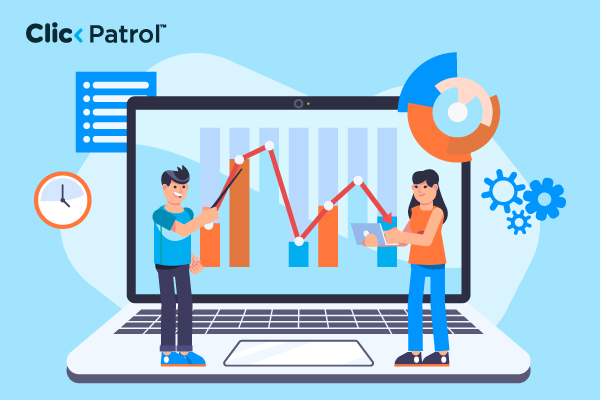Partial and slow refunds. Prevention, of course, is better.
ClickPatrol blocks malicious IPs before they can view or click your ads and provides evidence to support claims.
Abisola Tanzako | Nov 27, 2025

Competitor click fraud is a more serious form of click fraud, in which competitors or contracted click farms or bots intentionally click your ads.
Statista, the global advertising industry lost approximately $65 billion to digital ad fraud in 2021 alone.
Meanwhile, the ClickPatrol data itself shows that, on average, 14% of sponsored search ads are fraudulent.
In this article, you will learn about the real costs and methods behind competitive click fraud, case studies of how it impacts campaigns, the red-flag indicators to identify such fraud, and a practical approach to protect your ad budgets.
Most marketers know ad fraud as a broad category of bots, fake impressions, and domain spoofing.
Competitor click fraud, on the other hand, is narrow and intentional: it is a direct or contracted competitor, or their agent, who repeatedly clicks on your paid search or ads with the express purpose of:
Ad fraud in general is already significant and growing, and one source of those losses is competitor clicks.
2023 global digital ad fraud losses were estimated to be $84-88 billion, or 22% of total ad spend, and are expected to exceed $172 billion by 2028.
Up to 20% of all paid-search clicks are fraudulent or invalid, meaning one in every five interactions is wasted on non-human traffic that erodes ROI.
Bots and automated farms generate 30% of bad bot traffic, and that number is growing as more of these bots learn to disguise themselves as humans.
Fraudulent signals distort automated algorithms, inflating CPCs and skewing performance metrics in real-time bidding environments.
43% of all web traffic consists of invalid traffic, further undermining campaign optimization and trust in analytics.
The region faces $33 billion in annual losses, projected to double to $75 billion amid rapid digital growth and high fraud exposure.
SIVT now accounts for 17–34% of impressions, with advanced bots complicating attribution by evading basic filters.
Competitor clicks are worse than accidental invalid traffic because they are:
Competitors can schedule attacks to align with product launches or high-value campaigns, keeping clicks flowing until budgets are depleted.
Paid platforms are informed by conversions and clicks. Relevant and fake clicks flood campaigns with signals that are either irrelevant or fake. where algorithms make poor decisions (increased CPA goals, reduced placements).
Ad platforms do reimburse some invalid clicks, but manual competitor activity tends to be obscured behind proxies, repeating often enough to trigger automated limits; even when refunded, the damage to historical performance data is done.
Motogolf, a Las Vegas-based golf equipment retailer, filed suit after learning of repeated intentional clicks from a competing retailer’s devices that repeatedly exhausted daily budgets and removed Motogolf from potential customer view, disrupting demographic and performance insights.
The company claimed more than $5,000 in direct losses and pointed out that even small-scale competitor click attacks can materially harm revenue and strategic decision-making.
Not all invalid clicks are competitor attacks, but some red flags certainly suggest targeted competitor behavior.
Competitor click fraud harms more than immediate spend:
Competitor clicks can quickly drain your ad budget. Blocking malicious IPs is a practical way to stop these attacks in real time and protect your campaigns.
ClickPatrol is specifically engineered to stop targeted competitor click fraud by combining the above layers:
Competitor click fraud is a real and growing threat: it wastes ad spend, corrupts campaign data, and hurts ROI.
Ad platforms do some detection and issue refunds, but targeted competitor activity is best stopped at the source.
Blocking malicious IPs and preventing bad actors from seeing or clicking your ads is the fastest and most effective defence, and it’s just what ClickPatrol was built to do.
Start using ClickPatrol today to block competitor IPs in real time, prevent wasted ad spend, and boost your PPC ROI.
Partial and slow refunds. Prevention, of course, is better.
ClickPatrol blocks malicious IPs before they can view or click your ads and provides evidence to support claims.
Small and large advertisers alike are vulnerable; vertical and targeting determine exposure.
Granular blocking using IP ranges, device fingerprints, and VPN detection minimizes false positives.